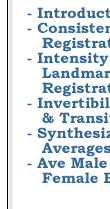
 |
|||||
 |
|||||
Next: Methods Up: index Previous: index
Introduction
Image registration algorithms are used to define correspondences between sets of images. Various characteristics of image data are exploited to drive image registration algorithms. The characteristics exploited range from designated landmark positions [1,2,3,4], to contours [5,6,7] or surfaces [8,9,10,11], to volumetric functions of voxel intensities [12,13,14,15,16,17,18,6,19,20,21].
There are many image registration algorithms based on the exact matching of corresponding landmarks in two images [22]. The unidirectional landmark thin-plate spline image (UL-TPS) registration technique pioneered by Fred Bookstein [1,2,23] is the most commonly used landmark driven non-rigid image registration algorithm. Generalizations of UL-TPS procedure include kriging methods [24,25] that use regularization models other than the thin-plate spline (TPS) model, anisotropic landmark interactions [4], and directed landmarks [26].
Most landmark based registration algorithms, including the ones described in this paper, assume that a small deformation is sufficient to register a set of images. In cases where the small deformation assumption holds, registration algorithms may efficiently estimate diffeomorphic transformations in a solution space that contain non-diffeomorphic transformations. The small deformation limitation is not universally applicable, and work by Joshi and Miller et. al.[27,28,29] estimates large deformation transformations in a solution space of diffeomorphisms by constraining the transformations to obey diffeomorphic fluid properties.
The UL-TPS algorithm (see Section II-B) defines a unique smooth registration from a template image to a target image based on registering corresponding landmarks. Correspondence away from the landmark points is defined by interpolating the transformation with a thin-plate spline model. Although thin-plate spline interpolation produces a smooth transformation from one image to another, it does not define a consistent correspondence between the two images except at the landmark points. This can be seen by comparing the transformation generated by matching a set of template landmarks to a set of target landmarks with the transformation generated by matching the target landmarks to the template landmarks. If the correspondence is consistent then the forward and reverse transformations will be inverses of one another. This is not the case as shown by the examples in Section III. Consistency of the forward and reverse transformations is a necessary condition to define a unique correspondence between two images since it insures that the correspondence defined by the forward transformation is consistent with the correspondence defined by the reverse transformation. Without consistency, the forward transformation would define one correspondence between the images while the reverse transformation would define a different correspondence.
The consistent registration methods presented in this paper builds on the unidirectional landmark and intensity methods described in [30] which used a Fourier series basis to parameterize the transformation and the method developed by Kybic [31] that used B-splines.
In this paper, the idea of consistent image registration [32,33,34] is combined with the UL-TPS algorithm [1,2,23,3,4] to overcome the problem that the forward and reverse transformations generated by the UL-TPS algorithm are not inverses of one another. In the consistent image registration approach, the forward and reverse transformations between two images are jointly estimated subject to the constraints that they minimize the thin-plate spline bending energy and that they are inverses of one another. The merger of these two approaches produced a consistent landmark-based thin-plate spline (CL-TPS) and a consistent landmark and intensity-based thin-plate spline (CLI-TPS) image registration algorithms. The CL-TPS algorithm (see Section II-C) provides a means to estimate a consistent pair of forward and reverse transformations given a set of corresponding points. The CLI-TPS algorithm (see Section II-A) combines both landmark and intensity information to estimate a consistent pair of forward and reverse transformations. The performance of these algorithms are compared using 2D MRI brain data images.
Next: Methods Up: index Previous: index Xiujuan Geng 2002-07-04
Copyright © 2002 • The University of Iowa. All rights reserved.
Iowa City, Iowa 52242
Questions or Comments: gary-christensen@uiowa.edu